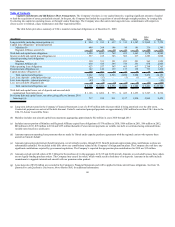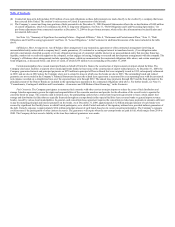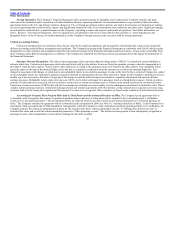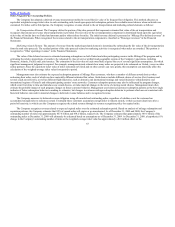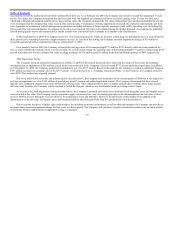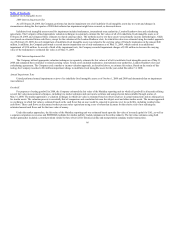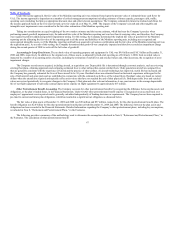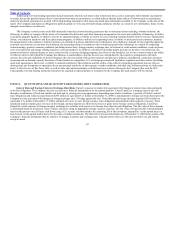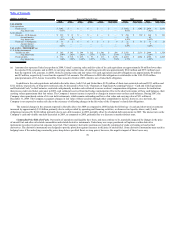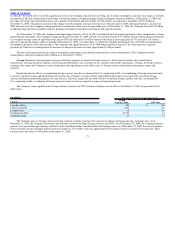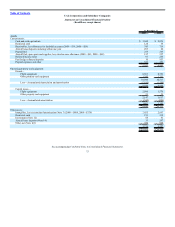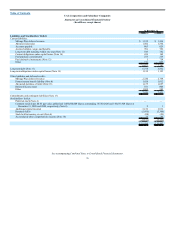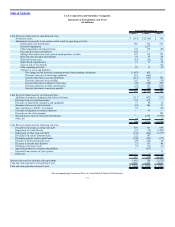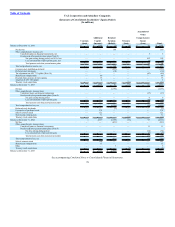United Airlines 2009 Annual Report Download - page 72
Download and view the complete annual report
Please find page 72 of the 2009 United Airlines annual report below. You can navigate through the pages in the report by either clicking on the pages listed below, or by using the keyword search tool below to find specific information within the annual report.
Table of Contents
expense and obligations requires the use of a number of assumptions, including the assumed discount rate for measuring future payment obligations and the
expected return on plan assets. The discount rates were based on the construction of theoretical corporate bond portfolios, adjusted according to the timing of
expected cash flows for the payment of the Company’s future postretirement obligations. A yield curve was developed based on a subset of these bonds (those
with yields between the 10th and 90th percentiles). The projected cash flows were matched to this yield curve and a present value developed, which was then
calibrated to develop a single equivalent risk-adjusted discount rate.
Actuarial gains or losses are triggered by changes in assumptions or experience that differ from the original assumptions. Under the applicable accounting
standards, those gains and losses are not required to be recognized currently as other postretirement expense, but instead may be deferred as part of accumulated
other comprehensive income and amortized into expense over the average remaining service life of the covered active employees. The Company’s accounting
policy is to not apply the corridor approach available under applicable GAAP with respect to amortization of amounts included in accumulated other
comprehensive income. Under the corridor approach, amortization of any gain or loss in accumulated other comprehensive income is only required if, at the
beginning of the year, the accumulated gain or loss exceeds 10% of the greater of the benefit obligation or the fair value of assets. If amortization is required, the
minimum amount outside the corridor divided by the average remaining service period of active employees is recognized as expense. The corridor approach is
intended to reduce volatility of amounts recorded in pension expense each year. Since the Company has elected not to apply the corridor approach, all gains and
losses in accumulated other comprehensive income are amortized to expense over the remaining years of service. At December 31, 2009 and 2008, the Company
had unrecognized actuarial gains of $155 million and $286 million, respectively, recorded in accumulated other comprehensive income for its other
postretirement benefit plans.
Valuation Allowance for Deferred Tax Assets. At December 31, 2009, UAL and United had valuation allowances applied to its deferred tax assets of
approximately $3.1 billion and $3.0 billion, respectively. In accordance with accounting principles related to income taxes, a valuation allowance is required to
be recorded when it is more likely than not that deferred tax assets will not be realized. Future realization depends on the existence of sufficient taxable income
within the carry forward period available under the tax law. Sources of future taxable income include future reversals of taxable temporary differences, future
taxable income exclusive of reversing taxable differences, taxable income in carry back years and tax planning strategies. These sources of positive evidence of
realizability must be weighed against negative evidence, such as cumulative losses in recent years. A recent history of losses would make difficult a
determination that a valuation allowance is not needed.
In forming a judgment about the future realization of our deferred tax assets, management considered both the positive and negative evidence of
realizability and gave significant weight to the negative evidence from our cumulative losses for recent years. Management will continue to assess the valuation
allowance and make appropriate adjustments based on the positive and negative evidence existing at that time. The Company is currently unable to forecast when
there will be sufficient positive evidence for it to reverse the remainder of the valuation allowances that are recorded. Any reversals of valuation allowance would
reduce income tax expense. See Note 7, “Income Taxes,” in the Footnotes for additional information.
Forward-Looking Information
Certain statements throughout Item 7, Management’s Discussion and Analysis of Financial Condition and Results of Operations and elsewhere in this
report are forward-looking and thus reflect the Company’s current expectations and beliefs with respect to certain current and future events and financial
performance. Such forward-looking statements are and will be subject to many risks and uncertainties relating to United’s operations and business environment
that may cause actual results to differ materially from any future results expressed or implied in such forward-looking statements. Words such as “expects,”
“will,” “plans,” “anticipates,” “indicates,” “believes,” “forecast,” “guidance,” “outlook” and similar expressions are intended to identify forward-looking
statements.
68




